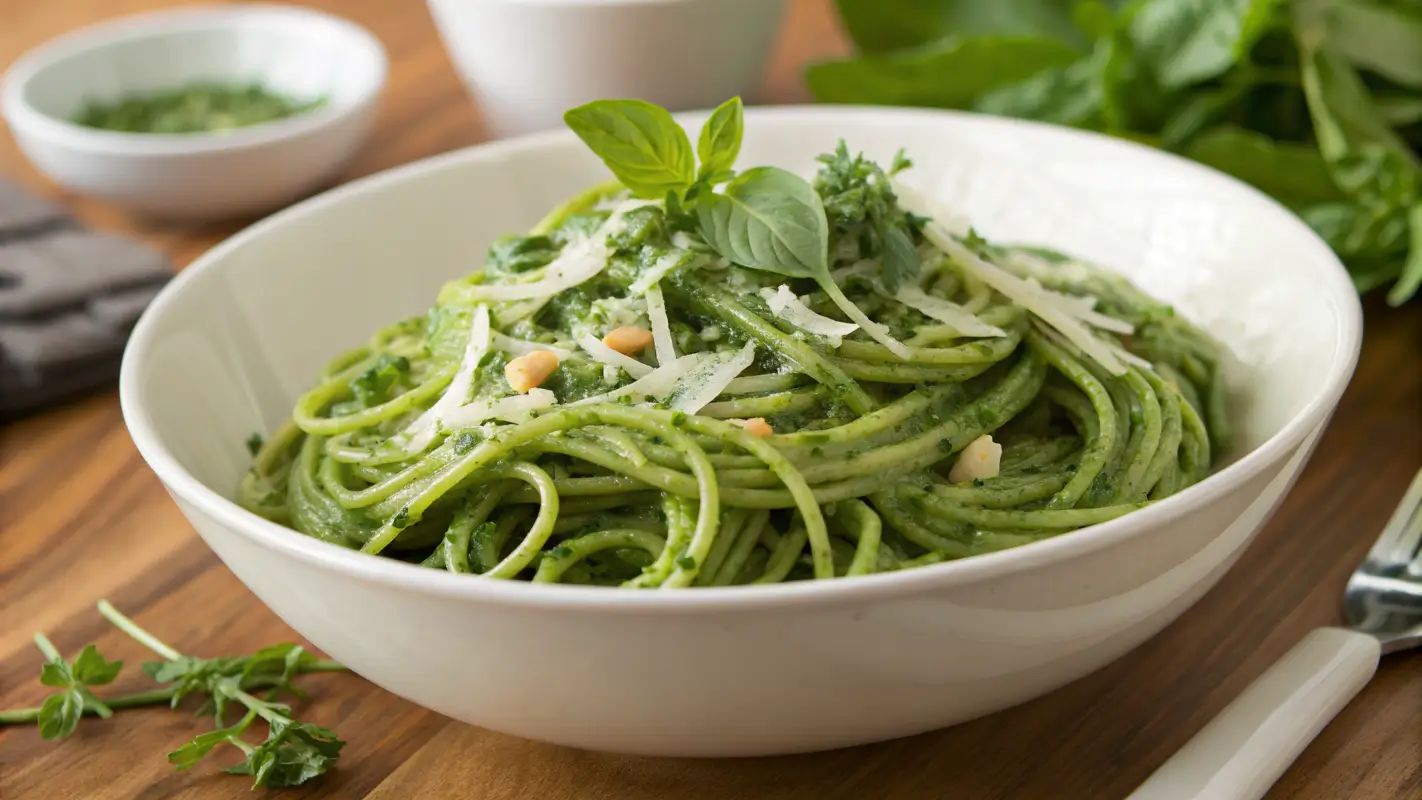Table of Contents
Green spaghetti is not your ordinary pasta dish—it’s a vibrant, flavorful twist on traditional spaghetti that brings together fresh vegetables, creamy sauces, and a punch of green goodness. Whether you’re looking to create a hearty dinner or a lighter, healthier alternative to the usual pasta, green spaghetti is a dish that packs in nutrition without compromising on flavor. In this guide, we’ll walk you through the steps to create this delightful meal, from the ingredients to some tasty variations you can try. So, get ready to make your own Green Spaghetti Recipe and elevate your pasta game!
Essential Ingredients for Green Spaghetti
To make the best green spaghetti, you need to start with quality ingredients. The beauty of this dish lies in the combination of fresh, green, and creamy components that come together to create a mouthwatering flavor profile. Let’s dive into the key ingredients you’ll need for this vibrant recipe.
Key Ingredients for Green Spaghetti
When it comes to green spaghetti, it’s all about the flavors of fresh greens, the richness of the sauce, and the perfect pasta base. Each ingredient has a specific role in creating that perfect balance of flavors.
Fresh Greens (Spinach or Kale)
One of the stars of the show in green spaghetti is the fresh greens you’ll use, and spinach is the most popular choice. Not only does it give the dish its signature green color, but it also packs in a ton of nutrients like vitamin A and iron. Alternatively, you can swap in kale for a slightly more robust flavor. Both greens work wonders in creating a creamy, herbaceous sauce that coats every strand of spaghetti.
Fresh Garlic
A little bit of garlic goes a long way in creating depth in the flavor. Garlic adds a subtle, savory kick that complements the freshness of the greens without overpowering them. You’ll sauté the garlic to bring out its aromatic qualities, making it a key player in your green spaghetti recipe.
Creamy Sauce Base (Cream, Avocado, or Pesto)
The creamy element is what binds the green spaghetti together, and there are various ways you can achieve that. A classic approach is to use heavy cream, which gives the dish richness and smoothness. Alternatively, for a healthier version, you could use avocado, blending it with the greens for a creamy consistency. You could even consider using a green pesto (basil, spinach, or arugula) as your sauce base, adding a fresh, herby flavor to the mix.
Parmesan or Pecorino Cheese
While not always essential, adding some Parmesan or Pecorino cheese brings a salty, umami flavor that complements the creamy sauce. A sprinkle of grated cheese adds richness and depth, making each bite a little more indulgent. It’s also an optional ingredient for those looking to make the dish dairy-free.
Spaghetti or Other Pasta
To finish off your green spaghetti dish, you need a solid pasta base. Traditional spaghetti works best, but feel free to experiment with other types of pasta, such as fettuccine, penne, or even zucchini noodles if you’re aiming for a gluten-free option. The key is to choose something that will hold the creamy sauce well and provide a satisfying texture.
Optional Ingredients for Added Flavor
Once you’ve nailed down the essentials, you can get creative by adding optional ingredients to take your green spaghetti to the next level. These additions can add flavor, texture, and a little bit of extra flair to your dish.
Pine Nuts or Walnuts
If you enjoy a bit of crunch, consider adding some toasted pine nuts or walnuts on top of your green spaghetti. Not only do they bring texture, but they also add a nutty richness that pairs perfectly with the greens and creamy sauce.
Fresh Lemon Juice
A little zest of lemon juice can go a long way in brightening up your green spaghetti and cutting through the richness of the sauce. It adds a refreshing contrast that brings out the freshness of the greens even more.
Fresh Herbs
Topping your green spaghetti with some fresh herbs, like basil or parsley, enhances both the flavor and visual appeal. Fresh herbs give the dish a pop of color and a boost of aromatic freshness.
Essential Ingredients and Equipment
To create the perfect green spaghetti, you’ll need a few essential ingredients and the right kitchen equipment. Here’s a rundown of what you need to bring your green spaghetti to life with ease.
Key Ingredients for Green Spaghetti
The heart of this dish lies in its fresh, flavorful ingredients that create a vibrant, creamy pasta experience.
Frozen or Fresh Green Vegetables (Spinach, Kale, or Peas)
As previously mentioned, fresh spinach is often the go-to for this dish, but if you’re in a pinch, frozen spinach works just as well. Spinach and kale are packed with vitamins, while peas are another great option to boost the green color and add a subtle sweetness to the dish. You can also experiment with other leafy greens like arugula for a bit of peppery zing.
Fresh Garlic and Onion
These ingredients form the base of your green spaghetti’s flavor profile. Garlic adds a depth of savory flavor, while onions bring sweetness and balance. When sautéed together, they create a fragrant base that pairs wonderfully with the greens.
Creamy Base (Heavy Cream, Avocado, or Cashews)
To make the sauce creamy, you can use different options depending on your dietary preferences. Heavy cream gives a traditional, rich texture, but for a lighter version, you can substitute with pureed avocado, which provides a similar creamy consistency. For a dairy-free option, soaked cashews blended with water or vegetable broth make a luscious, velvety base.
Cheese (Parmesan or Nutritional Yeast)
A little Parmesan or Pecorino adds an irresistible umami flavor to the sauce. If you’re making a dairy-free dish, nutritional yeast is a great substitute for that cheesy taste, while also providing a boost of vitamins and minerals.
Pasta (Spaghetti, Fettuccine, or Zucchini Noodles)
Traditional spaghetti is the go-to pasta for this dish, but you can switch it up by trying fettuccine, penne, or even zucchini noodles for a low-carb option. The key is to choose a pasta that holds the creamy sauce well.
Recommended Kitchen Equipment
Using the right tools will ensure that your green spaghetti comes together smoothly and efficiently. Here’s what you’ll need.
Large Pot for Boiling Pasta
You’ll need a big pot to boil your pasta. Make sure it’s large enough to give the spaghetti room to cook evenly.
Sauté Pan for Garlic and Greens
A large sauté pan or skillet is essential for cooking your garlic, onions, and greens. This pan will help to evenly sauté the vegetables without overcrowding.
High-Speed Blender or Food Processor
For that smooth and creamy sauce, a high-speed blender or food processor will work wonders. You’ll blend the cooked greens with your choice of sauce ingredients to create a velvety base.
Tongs or Pasta Fork
When it comes to tossing your pasta with the sauce, using tongs or a pasta fork will allow you to mix the spaghetti evenly and ensure every strand is coated in that delicious green goodness.
Measuring Cups and Spoons
Proper measurements are essential to get the balance of flavors just right. Accurate measuring ensures consistency in your recipe.
Step-by-Step Green Spaghetti Recipe
Now that you’ve got your ingredients and equipment ready, it’s time to dive into the preparation of your green spaghetti. Follow this simple step-by-step guide for a flavorful and creamy dish that will impress everyone at the table!
Preparing the Green Spaghetti
Boiling the Pasta
First, bring a large pot of salted water to a boil. Add your spaghetti (or chosen pasta) and cook according to the package instructions, usually around 8–10 minutes, until al dente. Once cooked, drain the pasta, reserving some of the pasta water for later use.
Sautéing the Garlic and Greens
While the pasta is cooking, heat some olive oil or butter in a large sauté pan over medium heat. Add the minced garlic and chopped onions and sauté for 2-3 minutes until they become fragrant and golden. Add your greens (spinach, kale, or peas) to the pan and cook for an additional 3-5 minutes, stirring occasionally until the greens have wilted and softened.
Blending the Creamy Sauce
Once your greens are cooked, transfer them to a high-speed blender or food processor. Add your choice of cream (or avocado/cashews) and blend until smooth and creamy. If the mixture is too thick, add a splash of pasta water to achieve the desired consistency. Season with salt, pepper, and any other spices you like (such as garlic powder, crushed red pepper flakes, or lemon zest).
Combining the Pasta and Sauce
Tossing the Spaghetti
Now it’s time to combine the pasta with the green sauce. In your sauté pan, toss the cooked pasta with the creamy green sauce, ensuring each strand of spaghetti is fully coated. If the sauce feels too thick, add a bit more of the reserved pasta water to thin it out.
Adding Cheese and Final Touches
Once the pasta is well-coated in the green sauce, sprinkle in some freshly grated Parmesan or Pecorino cheese. For a dairy-free version, you can add nutritional yeast to give it that cheesy flavor. Toss everything together and taste to adjust seasoning.
Serving and Garnishing
Transfer your green spaghetti to serving bowls. For an extra touch, sprinkle some freshly chopped herbs (basil, parsley, or arugula) on top, or add a sprinkle of toasted pine nuts or walnuts for crunch. Serve with an additional wedge of lemon for a refreshing burst of citrus!
Creative Variations and Pairings
Green spaghetti is versatile, allowing you to experiment with different flavors and add ingredients that suit your preferences. Let’s dive into some fun and creative ways to switch things up while still keeping the heart of the dish intact!
Flavor Enhancements
Adding Protein (Chicken, Shrimp, or Tofu)
For a heartier meal, you can add a protein to your green spaghetti. Chicken breast, grilled shrimp, or crispy tofu are fantastic choices. Grilled or pan-seared chicken adds a savory richness that complements the creamy green sauce. Shrimp brings a touch of sweetness and a light, fresh flavor, while tofu provides a protein-packed, vegetarian option.
Incorporating Nuts and Seeds
To add crunch and texture, sprinkle in some toasted pine nuts, walnuts, or pumpkin seeds. These not only provide a nice contrast to the creamy pasta but also boost the dish with healthy fats and a pleasant nutty flavor. Toasted almonds or sunflower seeds work well too!
Experimenting with Spices
If you’re craving a more adventurous twist, try infusing the green sauce with various spices. Adding a teaspoon of cumin, paprika, or curry powder can introduce warm, earthy notes that enhance the flavor. For a tangy, slightly spicy kick, toss in some cayenne pepper or chili flakes to taste.
Flavorful Greens Mix
While spinach is the usual star, don’t hesitate to mix in other leafy greens for added flavor. Try swapping some of the spinach for kale, arugula, or collard greens. These will bring a slight bitterness, balancing the richness of the sauce. You could also add a handful of fresh basil or mint for a refreshing, herbaceous note.
Meal Pairings
Now that you’ve made your green spaghetti, you’ll want to find the perfect side dishes and mains to go with it. Whether you’re enjoying it as a light lunch or a hearty dinner, here are some great options to complement your dish.
Complementary Side Dishes
A simple green salad or roasted vegetables can be a great side dish for your green spaghetti. A fresh salad with a tangy vinaigrette will offer a refreshing contrast to the rich, creamy pasta. Roasted zucchini, bell peppers, or asparagus work wonderfully as a side, adding a smoky and caramelized flavor that pairs beautifully with the pasta.
Main Course Pairings
Green spaghetti is hearty enough to be the main course but can also be paired with other proteins or dishes. Serve it alongside a grilled chicken breast, pan-seared salmon, or even a vegetarian lentil loaf. For a fun twist, you can also serve it as a side dish to a vegetarian lasagna or eggplant Parmesan, complementing the pasta’s green richness.
Storage and Reheating Tips
Got leftovers from your delicious green spaghetti? No worries! Here’s how to store and reheat your pasta to enjoy it another day while maintaining its fresh flavor and creamy texture.
Proper Storage Techniques
Refrigeration
If you have leftover green spaghetti, store it in an airtight container and refrigerate it within 2 hours of cooking. The pasta should stay fresh in the fridge for up to 3-4 days. However, keep in mind that the sauce may thicken as it cools, so you might need to add a splash of water or extra cream when reheating.
Freezing
If you want to store your green spaghetti for a longer time, freezing is a great option. Allow the pasta to cool completely, then transfer it into a freezer-safe container. To preserve the texture of the pasta and sauce, make sure to freeze it in individual portions. When ready to eat, simply defrost in the fridge overnight or reheat directly from frozen.
Reheating Methods
Stovetop
To reheat your green spaghetti on the stovetop, place it in a pan over medium heat. Add a splash of water, vegetable broth, or extra cream to the sauce to loosen it up. Stir frequently to ensure the sauce doesn’t burn or stick to the pan. Once heated through, give it a quick taste check and adjust the seasoning as needed.
Microwave
If you’re short on time, the microwave is the fastest way to reheat your green spaghetti. Place your pasta in a microwave-safe bowl and cover it loosely with a damp paper towel to prevent it from drying out. Heat on medium for 1-2 minutes, stirring halfway through. If it seems dry, add a little water or cream before reheating.
For additional healthy pasta variations, take a look at Olivemagazine’s Healthy Pasta Recipes.
FAQs About Green Spaghetti Recipe
How Do I Prevent Green Spaghetti from Becoming Soggy?
One of the biggest concerns when making green spaghetti is ensuring that the pasta stays fresh and not soggy. To prevent this, make sure you don’t overcook the pasta. Always follow the cooking time on the package and aim for al dente texture. When tossing your pasta with the green sauce, do it quickly while the pasta is still hot, ensuring that the sauce evenly coats the noodles without making them soggy. If the sauce becomes too thick, add a little bit of reserved pasta water to loosen it up and maintain a smooth consistency.
Can I Use Frozen Spinach Instead of Fresh for Green Spaghetti?
Yes, you can absolutely use frozen spinach in place of fresh spinach for your green spaghetti. It’s a great option when fresh spinach isn’t available. However, you’ll want to thaw the spinach first and squeeze out any excess water before blending it into your sauce. This will prevent the sauce from becoming too watery. The flavor will be just as delicious, and you’ll still get that vibrant green color!
How Can I Make Green Spaghetti Vegetarian or Vegan?
To make your green spaghetti vegetarian or vegan, you can easily swap out some ingredients. For a vegan option, replace the cream or cheese with coconut cream, cashew cream, or even a dairy-free cream alternative. If the recipe calls for Parmesan, you can use a plant-based alternative or simply skip it. For protein, consider adding tofu, tempeh, or chickpeas to keep the dish hearty and satisfying.
Can I Make Green Spaghetti in Advance?
Absolutely! Green spaghetti is a great dish to make ahead of time. You can prepare the sauce and store it separately from the pasta, then toss them together right before serving. If you plan to store the pasta with the sauce, be sure to refrigerate it in an airtight container for up to 3-4 days. Reheat on the stovetop with a little water or extra cream to keep it fresh. The flavors often deepen after a day or two, so it can be even tastier after resting!
How Long Does Green Spaghetti Last in the Refrigerator?
If stored properly, green spaghetti can last for about 3 to 4 days in the fridge. Be sure to place it in an airtight container to keep it fresh and prevent it from absorbing other odors. If you want to extend its shelf life, consider freezing the dish for up to 2-3 months.





